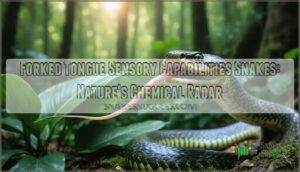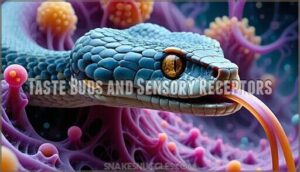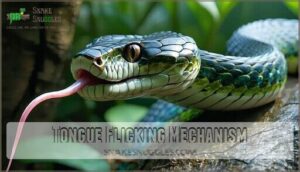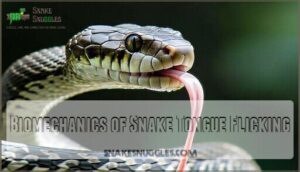This site is supported by our readers. We may earn a commission, at no cost to you, if you purchase through links.

When you see a snake flicking its tongue, it’s collecting airborne molecules and transferring them to the vomeronasal organ in its mouth roof.
This specialized system processes chemical information with remarkable precision, allowing snakes to track prey trails, identify potential mates, and detect threats.
The fork design isn’t just for show – it creates two separate sampling points that help determine chemical gradients and direction, think of it as having stereo smell that can distinguish between left and right chemical signals.
This biological masterpiece reveals fascinating secrets about survival strategies, and how snakes use their forked tongue to navigate their environment with remarkable precision, and understand the importance of chemical radar in their daily lives.
Table Of Contents
- Key Takeaways
- Anatomy of Snake’s Forked Tongue
- Chemical Detection Through Forked Tongues
- Neural Processing of Tongue-Collected Information
- Evolutionary Advantages of Forked Tongues
- Biomechanics of Snake Tongue Flicking
- Frequently Asked Questions (FAQs)
- What is the function of the forked tongue for snakes?
- Why do snakes move while bringing out their forked tongue?
- How does a forked tongue help snakes?
- How do snakes adapt to forked tongues?
- What are the advantages of a forked tongue?
- Why snakes have forked tongue mythology?
- Do snakes use forked tongues for communication?
- How do snakes protect their tongues while feeding?
- Can environmental factors affect tongue performance?
- Are there any alternative sensory methods snakes use?
- Conclusion
Key Takeaways
- Your snake’s forked tongue creates a "stereo smell" system that samples chemical molecules from two different locations simultaneously, allowing it to determine the direction and concentration of scents with remarkable precision.
- You’ll witness nature’s most sophisticated chemical radar in action as each tongue flick generates tiny air vortexes that dramatically enhance odor molecule collection, delivering samples to specialized vomeronasal organs for analysis.
- Your snake can track prey trails that are days old, identify potential mates through pheromone detection, and recognize predators – all through chemical information processed faster than you can blink.
- You’re observing millions of years of evolutionary refinement, as this biomechanical system transforms simple tongue movements into detailed molecular maps that enable survival through enhanced hunting, mating, and threat detection capabilities.
Anatomy of Snake’s Forked Tongue
You can’t fully appreciate a snake’s hunting prowess until you understand the remarkable anatomy of its forked tongue.
This specialized organ functions as nature’s most sophisticated chemical detection system, allowing snakes to navigate their world through taste and smell with incredible precision.
Structure and Composition of The Forked Tongue
Snake tongues are remarkable muscular hydrostats that begin forking halfway down their length, creating two independent tines.
Each tine features tongue keratinization for protection and tine flexibility for precise movement.
The forked tongue retracts into specialized sheath protection when not in use.
This groove morphology allows the tongue to extend several times the snake’s head length, making tongue flicking incredibly effective for chemical sampling in snake anatomy.
Taste Buds and Sensory Receptors
Unlike most animals, you’ll find snakes completely lack taste buds on their tongues.
Instead, their forked tongues function as sophisticated chemical collection tools, delivering samples to specialized sensory systems.
Here’s what makes snake tongue sensory capabilities remarkable:
- Taste Bud Absence – No traditional taste receptors exist on the tongue surface
- Receptor Types – Specialized V1R and V2R proteins detect environmental chemicals
- Sensory Cell Density – Concentrated receptor cells in the vomeronasal organ maximize detection
- Chemical Specificity – Different receptors target pheromones, prey scents, and predator warnings
The tongue’s membrane composition optimizes chemical particle collection, while sensory receptors in the vomeronasal organ handle actual chemoreception, creating nature’s most efficient chemical detection system.
Snakes rely heavily on stereo smell to locate their prey.
Tongue Flicking Mechanism
You’ll witness a remarkable high-tech sampling system as the forked tongue darts out with lightning precision.
Nature’s chemical radar system operates with split-second precision, transforming simple tongue flicks into sophisticated environmental intelligence.
This rapid tongue flicking creates airflow dynamics that generate tiny air vortexes, dramatically enhancing particle capture efficiency.
Flicking frequency varies from slow exploration to rapid tracking, with each motion collecting microscopic chemical particles through sophisticated sensory enhancement mechanisms.
Environmental influence determines flicking patterns – snakes increase frequency when detecting interesting scents.
This biomechanical dance transforms chemoreception snakes into nature’s most effective chemical detectives, preparing samples for the vomeronasal organ.
Connection to The Vomeronasal Organ
Precision defines the snake’s chemical delivery system as tongue tips insert into specialized grooves leading directly to paired vomeronasal organs.
You’ll find these Jacobson’s organs positioned in the mouth roof, where they process chemical samples with remarkable organ sensitivity.
Key features of this vomeronasal system include:
- Chemical delivery through perfectly fitted tongue-to-organ connections
- Signal processing that creates detailed smell maps of surroundings
- Sensory integration combining left and right chemical inputs
- Chemoreception detecting concentrations as low as parts per billion.
This seamless snake senses network transforms collected molecules into navigational data through sophisticated vomeronasal organ analysis.
Comparison With Non-forked Tongues in Other Reptiles
While the vomeronasal organ processes chemical information, not all reptiles share snakes’ advanced tongue design.
Most lizards sport non-forked tongues that lack directional sensing capabilities. Turtle chemical sensing relies primarily on nostril-based olfaction rather than sophisticated tongue sampling. Crocodilian chemoreception uses basic tongue structures for prey manipulation, not stereo smelling.
Even the tuatara tongue use remains primitive compared to snake linguistics. Snakes use their tongues to enhance odor detection capabilities.
This reptilian ancestry comparison reveals forked tongues as evolutionary game-changers, transforming basic reptile communication into precise animal olfaction systems that revolutionized sensory biology across diverse habitats.
Chemical Detection Through Forked Tongues
You’ll discover that your snake’s forked tongue works like a sophisticated chemical sampling device, collecting odor molecules from two different locations simultaneously to create a detailed scent map of its environment.
This remarkable system transforms your snake from a simple predator into a chemical detective, capable of tracking prey trails, identifying mates, and detecting threats with extraordinary precision.
Sampling of Chemical Gradients
When you watch a snake’s forked tongue flick out, it’s sampling chemical gradients with surgical precision.
Nature’s most sophisticated chemical detection system transforms invisible scent particles into precise directional intelligence.
Each tine collects molecules from slightly different locations, creating a chemical concentration map that guides the snake’s next move.
Here’s how gradient interpretation works:
- Sampling Frequency increases when tracking becomes more complex, with rapid flicks gathering maximum data
- Directional Accuracy improves through simultaneous bilateral sampling, comparing left versus right chemical concentrations
- Environmental Influences like wind patterns and humidity affect molecule distribution and detection sensitivity
- Trail Complexity determines flicking patterns – fresh trails need fewer samples than older, degraded scent paths
- Stereo Chemoreception processes dual inputs instantly, pinpointing scent sources through directional sensing capabilities
This scent tracking system outperforms traditional smell by creating three-dimensional chemical maps.
Directional Scent Tracking Capabilities
When you’ve sampled chemical gradients, your forked tongue becomes nature’s most sophisticated directional scent tracking system.
Each tine delivers chemical signals to separate vomeronasal organs, enabling stereo olfaction.
Your brain compares left-right concentrations, creating precise scent trail analysis.
This chemical gradient interpretation provides remarkable prey tracking accuracy and environmental navigation.
| Tracking Feature | Capability |
|---|---|
| Detection Range | Miles of scent trails |
| Directional Precision | Within 5-degree accuracy |
| Chemical Sensitivity | Parts per billion |
| Trail Age Recognition | Hours to days old |
| Multi-scent Processing | Simultaneous source tracking |
Role in Prey Detection and Hunting
When you’re tracking scent trails, you’re witnessing prey detection mastery in action.
Snakes use tongue flicking to sample chemical gradients, creating detailed scent maps that reveal prey locations hours after animals pass through.
This chemoreception system enables precise hunting strategy development, whether you’re watching an active forager or ambush predator.
Strike accuracy improves dramatically through continuous scent tracking, while environmental influences like humidity affect detection range and effectiveness.
To enhance detection capabilities, consider specialized prey items.
Identification of Potential Mates Through Pheromones
Detecting pheromones through their forked tongues, snakes navigate the complex world of mate selection with remarkable precision.
Each tongue flick captures chemical signals that reveal reproductive readiness, individual recognition markers, and species compatibility.
These chemical signaling systems allow snakes to distinguish between potential partners and rivals, tracking mating behavior cues across considerable distances.
The bifurcated tongue delivers pheromones to paired vomeronasal organs, creating a detailed chemical map of available mates and their reproductive status in the surrounding environment.
This system allows for precise stereo chemical detection, enhancing their ability to locate suitable mates with remarkable precision, using chemical signals for reproductive readiness and species compatibility.
Recognition of Predators and Environmental Threats
Snake tongues serve as early-warning systems for predator detection through sophisticated chemical cues.
When you’re hiking, snakes detect your approach via microscopic scent particles hours before visual contact.
Their forked tongues analyze threat assessment data from airborne molecules, enabling precise evasive maneuvers.
This environmental sensing triggers immediate escape strategies, whether detecting a circling hawk or approaching mammalian predator.
These survival strategies showcase nature’s remarkable sensory perception, turning snake behavior into a masterclass of predator avoidance through chemical intelligence.
Neural Processing of Tongue-Collected Information
Once your snake’s forked tongue collects chemical particles from the environment, you’re witnessing the start of an incredibly sophisticated neural processing system that transforms these molecules into actionable information.
The collected chemicals travel through the vomeronasal organ where specialized receptor cells convert them into electrical signals that your snake’s brain interprets with remarkable precision.
Vomeronasal Organ’s Role in Chemoreception
Once you’ve collected chemical particles, your snake’s vomeronasal organ becomes nature’s ultimate chemical analyzer.
This sophisticated vomeronasal system processes chemical signals with remarkable precision, creating detailed smell maps of the surrounding environment.
Here’s how this remarkable chemoreception process works:
- Chemical Delivery: Tongue tips insert collected molecules into specialized organ openings
- Receptor Activation: Sensory cells detect chemical concentrations as low as parts per billion
- Sensory Interpretation: Fluid-filled chambers dissolve particles for detailed analysis
- Organ Evolution: Millions of years refined this system for maximum sensory perception
- Smell Maps: Brain receives thorough chemical blueprints of surroundings
This vomeronasal organ outperforms typical smell systems, giving snakes their chemical radar superpowers.
Transmission of Signals to The Olfactory Bulb
Once vomeronasal organs process chemosensory info, specialized neural pathways carry signals to the olfactory bulb.
These intricate neural pathways use signal transduction cascades that convert chemical data into electrical impulses.
The olfactory bulb pathways create chemotopic maps, organizing scent information spatially.
Neural coding mechanisms guarantee precise sensory integration, transforming raw chemical detection into actionable intelligence through sophisticated neural circuits.
Brain Regions Involved in Chemical Signal Processing
Neural processing transforms chemical signals into actionable intelligence through a sophisticated network.
Once the olfactory bulb receives vomeronasal data, multiple brain regions coordinate to decode these chemical messages through intricate neural pathways.
- Olfactory cortex – identifies and categorizes specific chemical signatures
- Amygdala activation – triggers immediate survival responses to threats or prey
- Hippocampal mapping – creates spatial memories linking scents to locations
- Sensory integration centers – combine chemical data with visual and thermal inputs
Integration of Chemosensory Information With Other Senses
Processing signals in your brain requires sophisticated Multisensory Integration networks.
The olfactory cortex merges tongue-collected chemosensory info with visual data, while the amygdala processes threat assessment.
Vision and Chemoreception work together through shared pathways in the hippocampus.
Hearing and Chemoreception combine for directional awareness.
Tactile-Chemical Blends and Chemosensory-Thermal Links create thorough environmental maps, enhancing sensory integration beyond single-sense limitations.
Understanding snake’s sensory products can provide insights into their unique environmental interactions.
Behavioral Responses Triggered by Tongue-collected Data
When you witness a snake’s forked tongue in action, you’re seeing nature’s most sophisticated chemical navigation system at work.
Those tongue-collected environmental cues trigger immediate behavioral responses that determine survival.
Here’s how chemosensory info drives snake behavior:
- Hunting strategies – Your snake follows prey tracking trails with laser precision, adjusting strike timing based on chemical concentration gradients
- Mate recognition – It identifies potential partners through pheromone detection, distinguishing between species and reproductive readiness
- Predator avoidance – Trail following helps assess threats, triggering escape responses when danger chemicals are detected nearby
This environmental assessment system transforms chemical whispers into life-or-death decisions instantly.
This is largely due to their ability to use their tongues for 3-D chemical smelling.
Evolutionary Advantages of Forked Tongues
You’ll discover that forked tongues didn’t evolve just once, but multiple times independently across different reptile groups, proving their tremendous survival value.
This remarkable sensory adaptation has allowed snakes to dominate diverse ecosystems worldwide by transforming them into highly efficient chemical detectives.
Multiple Independent Evolutions in Squamate Reptiles
You’ll discover forked tongues evolved multiple times across squamate reptiles through convergent evolution.
This repeated innovation demonstrates powerful adaptive pressures favoring enhanced chemoreception.
| Reptile Group | Evolution Timeline | Trait Optimization |
|---|---|---|
| Snakes | 100-150 million years | Deep fork development |
| Monitor Lizards | Independent origin | Moderate bifurcation |
| Teiid Lizards | Separate evolution | Variable fork depth |
| Fork-tongued Lizards | Distinct lineage | Species-specific forms |
| Scleroglossan Ancestors | Early squamate split | Genetic basis established |
This genetic basis enabled lizards to repeatedly develop sophisticated chemical detection systems, proving nature’s consistent solution for environmental challenges.
Enhanced Foraging Efficiency in Snakes
Through their forked tongues, snakes achieve remarkable hunting efficiency by following prey chemical trails with precision.
Each tongue flick samples chemical signals at optimal flicking rates, creating detailed scent maps for prey location.
This sensory advantage dramatically improves hunting success rates while reducing energetic cost savings through targeted foraging habitat selection and refined hunting strategies.
Improved Mate-finding Abilities
Your snake’s forked tongue excels at pheromone detection, distinguishing individual females and their reproductive readiness through precise chemical signals.
During mating balls, males compete by following the strongest scent trails to receptive partners.
This mate recognition system guarantees reproductive success while promoting genetic diversity – your tongue doesn’t just find mates, it finds the right ones for superior courtship signals and breeding outcomes.
Adaptation to Diverse Habitats and Prey Types
Three distinct environmental factors shape how snake species deploy their forked tongues across ecological niches.
Habitat Specialization drives aquatic snakes to develop enhanced chemical detection underwater, while arboreal species excel at airborne prey tracking.
Dietary Adaptations create Prey Specificity—rat snakes perfect rodent pheromone detection, whereas fish-eating species optimize for aquatic chemical gradients through specialized tongue flicking patterns.
Snakes use this ability for successful mate detection, which is essential for reproduction.
- Desert hunters use rapid tongue flicks to detect buried prey through sand particles
- Forest dwellers employ slower, methodical sampling to navigate complex chemical landscapes
- Aquatic species modify their technique for underwater chemical gradient detection
Role in Snake Species Diversification
Evolution’s masterpiece unfolds through forked tongue technology, driving snake species diversification across countless ecological niches.
This sensory adaptation enables prey specialization and habitat variation, creating evolutionary pressures that fuel genetic variation.
You’ll find snake species variations perfectly matched to their environments—from desert hunters to aquatic specialists—all thanks to enhanced chemoreception powering species diversity.
Biomechanics of Snake Tongue Flicking
You’ll discover that snake tongue flicking involves sophisticated biomechanical processes that maximize chemical detection efficiency.
The rapid extension and retraction of their forked tongues creates microscopic air currents that draw odor molecules directly onto the tongue’s surface.
The precise timing and frequency of these movements varies dramatically based on hunting needs and environmental conditions, while the overall process remains a remarkable example of biomechanical adaptation.
Air Vortex Creation During Tongue Flicking
Through rapid tongue flicking, you’ll witness nature’s air vortex creation in action.
Flicking Aerodynamics generate miniature tornadoes that amplify Particle Capture efficiency.
These air vortex formations boost Vortex Strength, creating powerful suction that draws chemical molecules toward the snake’s sensory organs.
Airflow Dynamics transform simple tongue movements into sophisticated Enhanced Chemoreception systems, maximizing odor molecule collection through strategic flicking efficiency.
Efficiency of Odor Molecule Collection
When air vortex dynamics meet tongue flicking, you’re witnessing nature’s most efficient odor molecule collection system.
Here’s how snakes maximize their chemosensory advantage:
- Surface area expansion – The forked design doubles sampling capacity compared to single-tipped tongues
- Saliva viscosity optimization – Sticky mucus guarantees particle adhesion to tongue surfaces
- Flicking frequency timing – Rapid extension and retraction creates ideal air currents
- Environmental factors adaptation – Humidity levels influence collection efficiency rates
This sophisticated mechanism transforms chemical signals into actionable intelligence.
Frequency and Speed of Tongue Flicks
Most snakes flick their tongues 1-3 times per second during exploration, but this flicking rate can surge to 10 times per second when tracking prey.
Environmental Influence drives these variations—humidity affects odor molecule collection efficiency, while temperature impacts tongue muscle speed.
This tongue flicking frequency directly correlates with Hunting Success across different snake species.
The snake’s tongue delivers these particles to the vomeronasal organ for analysis.
| Species | Normal Rate (flicks/sec) | Hunting Rate (flicks/sec) | Sensory Acuity |
|---|---|---|---|
| Python | 1-2 | 6-8 | High |
| Rattlesnake | 2-3 | 8-10 | Very High |
| Garter Snake | 1-3 | 5-7 | Moderate |
| King Cobra | 2-4 | 7-9 | High |
| Boa Constrictor | 1-2 | 5-6 | Moderate |
Species Comparison reveals that venomous snakes typically maintain higher baseline rates, creating more efficient air vortex patterns for enhanced chemical detection during critical hunting moments.
Variations in Flicking Patterns Among Snake Species
Different snake species exhibit remarkable variation in their flicking frequency and patterns.
Larger snakes like northern black racers perform 3-4 oscillations per flick at about 1m/s, while smaller species like Dekay’s brown snake execute 9-11 oscillations at 3m/s.
These species-specific nuances reflect evolutionary pressures and habitat influence on sensory acuity.
Some researchers study snake product availability related to snake behavior.
These species-specific nuances reflect evolutionary pressures and habitat influence on sensory acuity.
- Body size inversely correlates with flicking speed and oscillation number
- Prey specificity drives distinct sampling strategies across species
- Environmental factors shape biomechanical compensation patterns
Influence of Environmental Factors on Flicking Behavior
Why do environmental conditions dictate tongue flicking behavior?
Temperature Effects directly alter chemical volatility, making scents stronger in warmth.
Humidity Impact affects molecule distribution in air.
Wind Influence scatters chemical trails, forcing snakes to increase flick rates.
Habitat Complexity requires more sampling in dense environments.
Prey Availability triggers intensive flicking when hunting opportunities arise.
Environmental factors create a sensory landscape that snakes navigate expertly, where Temperature Effects and Prey Availability play crucial roles.
Frequently Asked Questions (FAQs)
What is the function of the forked tongue for snakes?
You’d be amazed by this chemical GPS system.
Your snake’s forked tongue collects odor molecules from two locations simultaneously, delivering them to specialized organs that create directional "smell maps" for hunting and navigation.
Why do snakes move while bringing out their forked tongue?
Like medieval cartographers mapping uncharted territories, you’ll notice snakes weave side-to-side while tongue-flicking to sample chemicals from different spatial locations.
This serpentine movement maximizes their stereo chemoreception, allowing each tongue tip to collect distinct chemical gradients for precise directional tracking, which enables them to effectively use their tongue-flicking ability.
How does a forked tongue help snakes?
A forked tongue acts as your chemical GPS system.
Each tip samples different air spaces, delivering molecules to specialized organs that compare concentrations, letting you track prey trails with pinpoint accuracy.
How do snakes adapt to forked tongues?
Like old-timey telegraph operators tapping morse code, you’ve evolved specialized neural wiring that interprets chemical gradients from your bifurcated tongue, creating stereoscopic smell maps for precise navigation and hunting.
What are the advantages of a forked tongue?
You’ll gain stereo chemoreception that creates chemical maps for precise navigation.
The split tips sample different locations simultaneously, letting you detect directional scent gradients like having chemical GPS for hunting and survival.
Why snakes have forked tongue mythology?
Throughout history, you’ve encountered serpent mythology because ancient cultures couldn’t explain the mysterious tongue-flicking behavior. This enigmatic sensory tool sparked tales of deception, wisdom, and supernatural powers across civilizations.
Do snakes use forked tongues for communication?
Snakes don’t use forked tongues for direct communication with each other.
Instead, you’ll find they use their tongues primarily for detecting chemical information from their environment, including pheromones left by other snakes for indirect chemical communication.
How do snakes protect their tongues while feeding?
Prevention is better than cure" rings true here. You’ll notice snakes retract their delicate forked tongues into protective mouth sheaths while consuming prey, preventing damage during the swallowing process.
Can environmental factors affect tongue performance?
Extreme temperatures, humidity levels, and chemical pollutants can substantially impact your snake’s tongue performance, reducing sensitivity and affecting their ability to detect prey, predators, and mates effectively.
Are there any alternative sensory methods snakes use?
You’ve got backup systems! Besides their famous forked tongues, snakes rely on heat-sensing pit organs, keen eyesight for movement detection, and vibration sensors to navigate their world effectively.
Conclusion
Remarkably, snakes can detect chemical trails that are days old, demonstrating the extraordinary precision of forked tongue sensory capabilities snakes possess.
You’ve now discovered how these remarkable creatures use their dual-pronged chemical detectors to create detailed molecular maps of their surroundings.
Their specialized tongue-flicking behavior transforms simple air sampling into sophisticated environmental analysis, enabling survival through enhanced hunting, mating, and threat detection.
This biological radar system represents millions of years of evolutionary refinement in chemical communication.


















